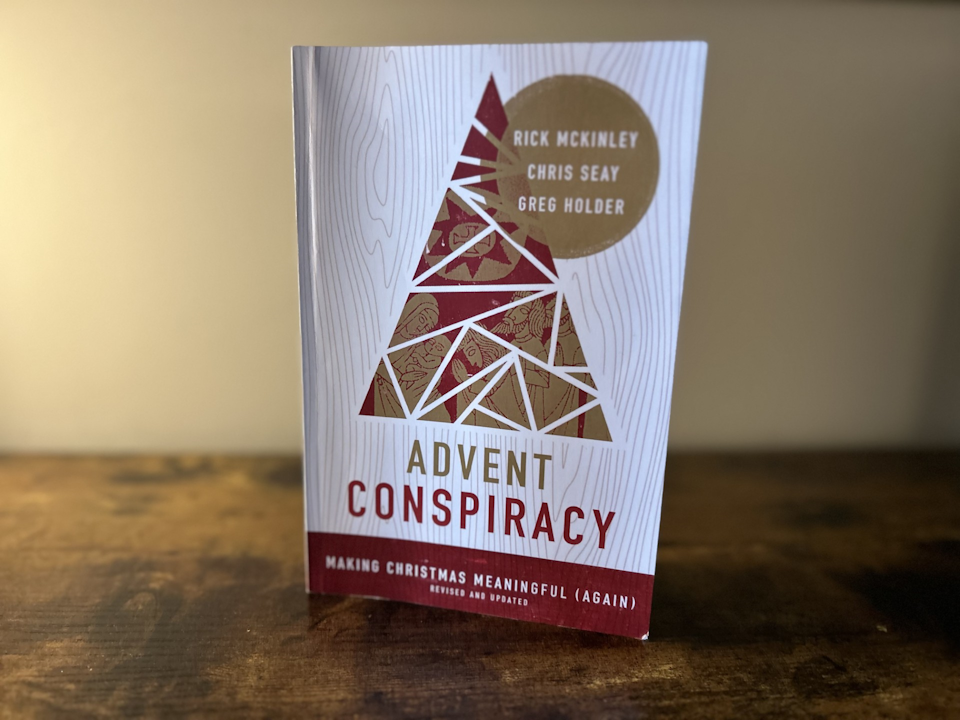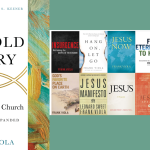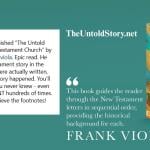
As we step into a new year, I am finding that it is the perfect time to reflect on how we celebrated the past season and consider new patterns for the year ahead. In this post, I explore some of my own post-Christmas reflections and how the Advent Conspiracy movement challenges us to rethink our approach to Christmas – moving away from consumerism and towards a way of celebration that is rooted in the hope of the incarnation. I also offer a review of the updated Advent Conspiracy (Again) book. More importantly, I hope you will hear the invitation of 1 Thessalonians 4:11 to “lead a quiet life and mind our own business.” As we resist the rush of the season, finding stillness in God’s presence, minding our own business, which includes avoiding the trap of comparison, and as we work with our hands, or invest in relationships with our hands, may we find the freedom of being dependent on no one, living without the burden of debt.
The Advent Conspiracy Challenges Us to a Different Way
Many of us are wrestling with the emotions and post-apocalyptic stress of the season. In Advent Conspiracy (Again), authors Rick McKinley, Chris Seay, and Greg Holder reflect: “The creator of the cosmos chose, from among his numberless galaxies and spinning stars, one tiny rock of a planet on which he entered human life in the most natural and self-effacing of ways – through the womb of a willing teenage girl.” Let that sink in for a moment. In the vastness of eternity and the seemingly unceasing expanse of the cosmos, our third rock from the sun experienced the miraculous and abnormal birth of the Christ—Jesus, the messianic messenger we as Christians believe to be the long-promised and prophesied messenger of God. Yet, in this season of miraculous incarnation, which is undoubtedly marked by humble beginnings, we often find ourselves with schedules void of margin, calendars packed too full, and minds lacking the space for intentional spiritual discipline and reflection that this rhythm of our calendar is due. In this busyness, we each “routinely miss the wonder of God’s miraculous birth.” In this light, the authors of the Advent Conspiracy (Again) mention, “our overstuffed Decembers leave us wanting more. Our hyper-consumption leaves us empty. We worship less. We spend more. We give less. We struggle more.” Somewhere along the way we have lost sight of the simplicity, beauty, and wondrous awe of the story of Christ’s birth.
After the Gifts: A Post-Christmas Reflection on Simplicity and What Truly Matters
There was a time in my life when everything I owned fit into a hardback, blue Samsung suitcase and a backpack. That suitcase was covered in stickers from bands and artists I had worked with, places I had been, and causes I supported. The idea of packing up and following a star wouldn’t have seemed out of the ordinary during that era, nor would it have been difficult, since I wasn’t weighed down by debt or possessions. This week, on the heels of Christmas, I can’t help but long for that simplicity once again. Over the years, health challenges have led to financial debt, and our house, which has rooted us in place, is in constant need of expensive repair. Our income feels limited, and it’s easy to look around at others in our circles and feel as though their lives are somehow better. Their houses, their belongings, and the quality of those the “things” they have seem to be lightyears ahead of where we are. It can lead us to a defeating feeling of being “stuck,” a much different reality than my suitcase years. I’m convinced that the way in which Americans are enslaved isn’t through the loss of rights or the taking of guns, but through the power games played by politicians and corporations—that are keeping us dependent on debt through inflation, consumerism, and a lack of financial stability.
Yet, as I begin what will likely be a year-long project of cleaning out our kids’ rooms and the basement in a house we’ve only lived in for ten years, I’m amazed at how much stuff we’ve accumulated. As Americans, we often express our love through gift-giving, and our culture convinces us we should, but it also convinces us that we need more and better things. However, the minute I crawled under my daughter’s bed and found piles of unplayed-with toys, dirty laundry, and broken presents from years past, I realized how easily I’ve bought into this form of enslavement (and that we didn’t have as many missing socks as we thought we did). I was also struck by the emotional attachment we form with our belongings. This isn’t just true for my daughters and their possessions, but also for the accumulation of things in our basement that I’m not ready to part with—things at times that I can’t even remember the last time I used.
So, this journey is helping me to make small progress. On the heels of Christmas, I am realizing that I want to celebrate differently. There have been times I have celebrated better. Right now, with heaps of bags going to the trash, consignment shops, and thrift stores – I begin to work on retraining my brain, forming new neural pathways, and setting resolutions to change certain habits. But there’s still a long way to go.
The Birth of the Advent Conspiracy
This is the reality that the authors of Advent Conspiracy (Again) are wrestling with. When the Advent Conspiracy movement began in 2006, three pastors were grappling with their own struggles around consumerism and overstuffed Decembers. Rather than continuing to celebrate Advent and Christmas in the same way they had in previous years, they wanted to find a way to truly enter the story. They share that, “From the beginning this idea of a conspiracy made sense to us – we followers of King Jesus would conspire with other like-minded believers to resist what presses in on each of us during the Advent season.” Their goal was to begin engaging with the story of the birth of Jesus in transformative ways – by entering the story and mirroring it in their Christmas celebrations in ways that the scriptures dictate much more than the way culture has discipled us. Rather than from a place where “We worship less. We spend more. We give less. We struggle more” the authors wanted to worship more, spend less, give more, and love all.
The Advent Conspiracy movement began small, with just a few churches seeking to make the Advent story personal again. That first year, they raised enough money for a water well in West Africa. The idea quickly spread, a book was written, and a revolution was born. Over the past decade, thousands of churches have embraced more relational traditions, partnered with organizations, and directed resources to the poor and marginalized. Advent Conspiracy is a movement where the body of Christ works together to tell the story of Jesus to the world by worshiping fully, spending less, giving more, and loving all.

Reviewing and Wrestling with Advent Conspiracy (Again)
The Advent Conspiracy book was first released in 2009 by Zondervan, a few years after the movement began. Over the years, I’ve revisited the first edition every few years. Early in our journey as parents, we had done well at resisting the consumerism of society at Christmas, focusing instead on relational gifts and the gift of presence. However, over time, the promises of consumerism and the temptation of easy gifts crept back in. Even more, the pressures of loving and providing for our kids in ways I didn’t have growing up. So, here I am- someone who once lived out of a suitcase, who resisted the holiday season’s pressures, and had led several Advent Conspiracies in different church communities – once again struggling with the season.
This year, we didn’t give many gifts compared to previous years, and we still gave relational gifts that reflect our values, like family memberships to zoos and other places that encourage time together. Yet, I still found myself affected by the season’s expectations. I felt like I wasn’t enough, wasn’t doing enough, or wasn’t giving enough – I wanted to express my love well to my children. I found myself picking up easy little knick-knacks on sale, even though our house is already overwhelmed with things.
A few weeks ago, I sat down with the new edition of the book, released in 2009 (which I bought from Church Source). After spending the morning walking a labyrinth at the Valley Friends Meeting, I decided to read Advent Conspiracy (Again) (released by Zondervan) in the most peculiar of places—the belly of the beast: a Capital One Café in the King of Prussia Mall, Philadelphia’s premier shopping destination with over 450 stores and 30 eateries. As I looked at a seasonally draped store, decorated with the promise of credit and various sales, I wrestled with the contrasts, and I wrestled with what was happening inside me (over some good coffee I will admit). The second edition of this book introduces slight changes, new artwork, and adds a few new chapters – overall offering fresh insights while maintaining the essence of the original message.
Like its predecessor, this edition of Advent Conspiracy (Again) is structured as a book but primarily functions as a resource for small groups, sermon series, and discussions within the Advent Conspiracy movement. In fact, there is a DVD and additional resources available to lead this as a series in a communal setting. While I’ve never found the writing of these authors to be deeply theological, ideological, or full of unconsidered information, it still serves its purpose well (though I’d like to see some more attention to depth in the future). For those seeking to rediscover the heart of Advent and engage in a movement of transformative faith, this resource is an excellent starting point. Despite its simplicity, it holds a mirror to its readers, inspiring individuals and communities to reclaim the true meaning of Christmas by challenging the consumerism and excess that have overshadowed the heart of the Advent season. The authors do provide a prophetic challenge to the way we have celebrated Christmas, because the way we have celebrated causes us to miss “the prophetic mystery of Jesus’ birth” which means we are “missing God-with us, God beside us-God becoming one of us. Missing out on Jesus changes everything.” This is the central tenet of the book.
The book details not only the origins of the Advent Conspiracy movement but it also offers inspiring stories of transformation, both locally and globally, of those who have been part of this way of celebrating Christmas – those part of the Advent Conspiracy movement. The book certainly inspires, equips readers and groups to challenge the dominant consumerist narrative of Christmas and rediscover (and join in as ambassadors of) the liberating simple gospel of God’s hope, peace, love, and joy that Advent proclaims.
The Main Tenets of Advent Conspiracy (Again)
In this book, the authors first help us to see that “Every day advertisements implore us to get more from life.” These advertisements tell us that “Fulfillment is within our grasp – and we deserve it. Why wait when we can have everything now?” The truth is that fulfillment, in the form of godly contentment experienced in Jesus alone, is within our grasp – it is a fruit of the Spirit-living, a way of the Kingdom of God that is also at hand. In this way, we find that “It is now clear that a primary threat to true Christianity in America is consumerism – not liberalism, fundamentalism, Darwinisim, secularism, or any other -ism that happens to achieve some level of influence and power.” The reason is because “Consumerism promises transcendence.” We are told “that the material thing we want most [or that they are selling us] will elevate us above our current circumstances.” Consumerism is a religion falsely offering us a way, truth, and quality of life, but Jesus’ words remind us that the only way, truth, and life is found in the son of God.
The authors then call us to a way of celebrating Christmas that is about worshiping fully, spending less, giving more, and loving all.
- Worshiping Fully. We enter the Christmas story through worship. Worship includes, but is not limited to, our church gatherings and our song. It also includes the way we live out obedience and extend hospitality to those spiritually lost, with the least, and in last place. The authors challenge, “Our Liberating King’s entrance stands in contrast with Herod’s tyranny – and that of the surrounding empires. Herod’s citizens were controlled by military power, financial strength, and technological development. But Jesus’ kingdom rises up differently. Jesus reveals his kingdom in vulnerability, solidarity with the poor, and self-sacrifice – far from the worldly power of Herod’s world.”
- Spending Less. This section calls us to avoid the trap of easy gifts. The authors themselves say, “Spending less requires us to plan, research, and cultivate relationships – pursuits that are more taxing than flipping through the latest catalog or binging online.” We may find that ““Spend less” is an ambiguous goal. Spend less than last year? Spend less than my neighbor? Spend less than the average American, who spends almost one thousand dollars on Christmas gifts? Yes and no. The key is to ask such questions aloud and then be willing to engage the emerging tensions. How much is too much? How can you tell when you have too much?”
- Giving More. The point of spending less isn’t so that you don’t give at all. The authors’ point is that “We can all agree that there is still something deeply moving and beautiful about certain gifts.” In all honesty they argue that, “The simple truth is why giving is still a good way to celebrate the birth of Jesus.” However, learning to give more is about giving like Jesus gave, with relationships at the center. Giving more “also points to a way out of the chaos of consumerism that Christmas has become, taking us back to the joy that can still be found at the heart of this story. Our giving can [and should] actually reflect in some small way the power and beauty of God coming into our world as one of us.”
- Loving All. Love is at the center of the incarnation, and it is an expression of who God is, because God is love. The authors reflect that “Jesus gave up the glory of heaven to be born into a sin-scarred world. That glorious night in Bethlehem, every day of his life, and in the deadly pain of the cross, Jesus became poor for our sake. Jesus entered our poverty so we would no longer be poor.” In the same way, Advent calls us to be centered on love, living a way of love that does not allow “the broken and vulnerable world to become invisible.”
One of the book’s most striking messages is the call to replace material presents with the gift of presence. Readers are invited to give more of their time, talents, love, and ultimately themselves. The authors challenge us to resist cultural norms and reclaim the heart of Christmas: worshiping Jesus and embodying God’s love in the world. This book reminds us that the heart of our worship and celebration, how we worship and celebrate, must be an incarnation act itself, representing the story of God’s Son entering our world out of God’s love, for the deliverance of humanity. Out of God’s great love, God chose to dwell among us, bringing us hope and liberation from our physical and spiritual enslavement. Make sure your Christmas isn’t re-enslaving you. The Advent Conspiracy is about becoming co-conspirators in the ongoing Advent story, declaring to the world that God has given us the greatest gift of all.
Some Closing Thoughts
Jesus warns against the love of money and the dangers of greed that can shape our lives, even suggesting that our possessions may try to define us but ultimately don’t (Luke 12:15). While possessions themselves aren’t inherently wrong, Jesus teaches that they are not for collecting or hoarding but for stewarding and investing in the work and ways of the Kingdom of God (Matthew 25:14-30). Though many of us worry about not having enough, Jesus calls us to trust Our Father, God, for our daily bread and to avoid anxiety over material concerns (Matthew 6:25-34). In fact, Jesus’ way of living and his teaching emphasizes the cost of commitment to witness to the ways, words, and works of the Kingdom of God, and we learn that for many, idolized possessions stand in the way of our ability to fully follow (Luke 14:28-30).
I first encountered Advent Conspiracy over a decade ago in the Lancaster Vineyard Church pastored by Jerry Shannon in Lancaster, Pennsylvania. Since then, it has profoundly shaped how my family celebrates Christmas. It has also become a meaningful series I’ve introduced in various church contexts, across a range of theological backgrounds. This year, it is re-introducing me to make some adjustments as I head into a new year. It is causing me to begin the year with greater intentionality so that when Christmas comes around, I am not swept up in the current of the season and so I can stay faithful to not only my values of leading a quiet life.
We are stepping into a new year. This is a good time to wrestle with the season and plan a new way forward. I hope you to will hear the invitation of 1 Thessalonians 4:11 to “lead a quiet life and mind our own business.” As we resist the rush of the season, finding stillness in God’s presence, minding our own business, which includes avoiding the trap of comparison, and as we work with our hands, or invest in relationships with our hands, may we find the freedom of being dependent on no one, living without the burden of debt.
Read Highlights & Quotes (for full citations I used and more)













